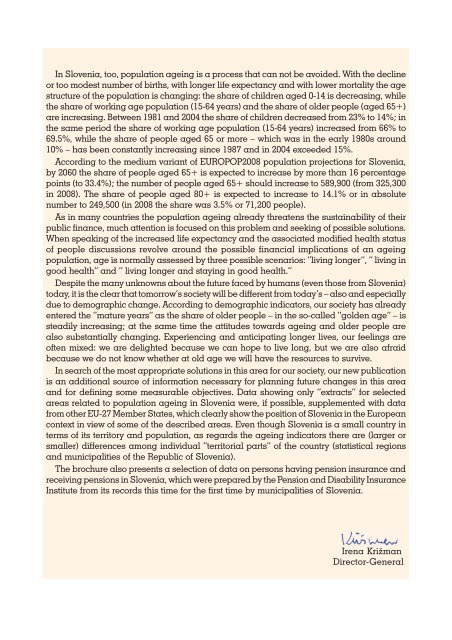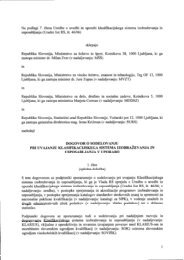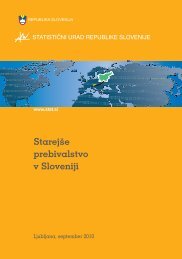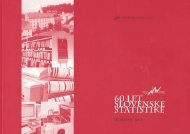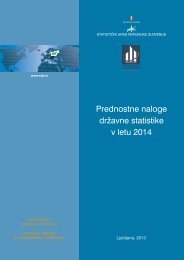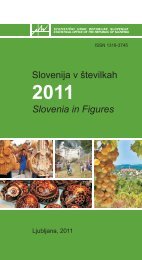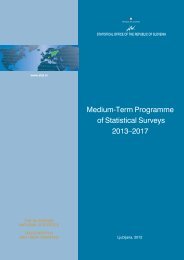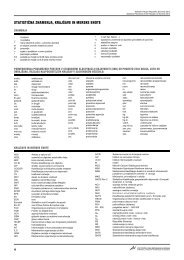The Elderly in Slovenia
The Elderly in Slovenia
The Elderly in Slovenia
- No tags were found...
You also want an ePaper? Increase the reach of your titles
YUMPU automatically turns print PDFs into web optimized ePapers that Google loves.
In <strong>Slovenia</strong>, too, population age<strong>in</strong>g is a process that can not be avoided. With the decl<strong>in</strong>eor too modest number of births, with longer life expectancy and with lower mortality the agestructure of the population is chang<strong>in</strong>g: the share of children aged 0-14 is decreas<strong>in</strong>g, whilethe share of work<strong>in</strong>g age population (15-64 years) and the share of older people (aged 65+)are <strong>in</strong>creas<strong>in</strong>g. Between 1981 and 2004 the share of children decreased from 23% to 14%; <strong>in</strong>the same period the share of work<strong>in</strong>g age population (15-64 years) <strong>in</strong>creased from 66% to69.5%, while the share of people aged 65 or more – which was <strong>in</strong> the early 1980s around10% – has been constantly <strong>in</strong>creas<strong>in</strong>g s<strong>in</strong>ce 1987 and <strong>in</strong> 2004 exceeded 15%.Accord<strong>in</strong>g to the medium variant of EUROPOP2008 population projections for <strong>Slovenia</strong>,by 2060 the share of people aged 65+ is expected to <strong>in</strong>crease by more than 16 percentagepo<strong>in</strong>ts (to 33.4%); the number of people aged 65+ should <strong>in</strong>crease to 589,900 (from 325,300<strong>in</strong> 2008). <strong>The</strong> share of people aged 80+ is expected to <strong>in</strong>crease to 14.1% or <strong>in</strong> absolutenumber to 249,500 (<strong>in</strong> 2008 the share was 3.5% or 71,200 people).As <strong>in</strong> many countries the population age<strong>in</strong>g already threatens the susta<strong>in</strong>ability of theirpublic f<strong>in</strong>ance, much attention is focused on this problem and seek<strong>in</strong>g of possible solutions.When speak<strong>in</strong>g of the <strong>in</strong>creased life expectancy and the associated modified health statusof people discussions revolve around the possible f<strong>in</strong>ancial implications of an age<strong>in</strong>gpopulation, age is normally assessed by three possible scenarios: “liv<strong>in</strong>g longer”, “ liv<strong>in</strong>g <strong>in</strong>good health” and “ liv<strong>in</strong>g longer and stay<strong>in</strong>g <strong>in</strong> good health.”Despite the many unknowns about the future faced by humans (even those from <strong>Slovenia</strong>)today, it is the clear that tomorrow’s society will be different from today’s – also and especiallydue to demographic change. Accord<strong>in</strong>g to demographic <strong>in</strong>dicators, our society has alreadyentered the “mature years” as the share of older people – <strong>in</strong> the so-called “golden age” – issteadily <strong>in</strong>creas<strong>in</strong>g; at the same time the attitudes towards age<strong>in</strong>g and older people arealso substantially chang<strong>in</strong>g. Experienc<strong>in</strong>g and anticipat<strong>in</strong>g longer lives, our feel<strong>in</strong>gs areoften mixed: we are delighted because we can hope to live long, but we are also afraidbecause we do not know whether at old age we will have the resources to survive.In search of the most appropriate solutions <strong>in</strong> this area for our society, our new publicationis an additional source of <strong>in</strong>formation necessary for plann<strong>in</strong>g future changes <strong>in</strong> this areaand for def<strong>in</strong><strong>in</strong>g some measurable objectives. Data show<strong>in</strong>g only “extracts” for selectedareas related to population age<strong>in</strong>g <strong>in</strong> <strong>Slovenia</strong> were, if possible, supplemented with datafrom other EU-27 Member States, which clearly show the position of <strong>Slovenia</strong> <strong>in</strong> the Europeancontext <strong>in</strong> view of some of the described areas. Even though <strong>Slovenia</strong> is a small country <strong>in</strong>terms of its territory and population, as regards the age<strong>in</strong>g <strong>in</strong>dicators there are (larger orsmaller) differences among <strong>in</strong>dividual “territorial parts” of the country (statistical regionsand municipalities of the Republic of <strong>Slovenia</strong>).<strong>The</strong> brochure also presents a selection of data on persons hav<strong>in</strong>g pension <strong>in</strong>surance andreceiv<strong>in</strong>g pensions <strong>in</strong> <strong>Slovenia</strong>, which were prepared by the Pension and Disability InsuranceInstitute from its records this time for the first time by municipalities of <strong>Slovenia</strong>.Irena Kri`manDirector-General


